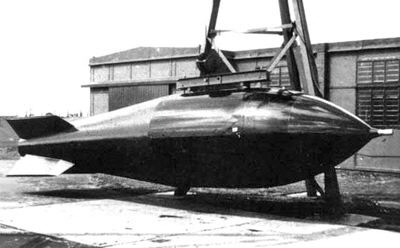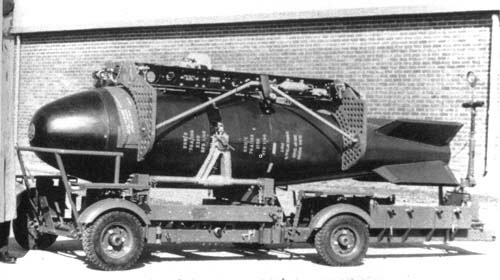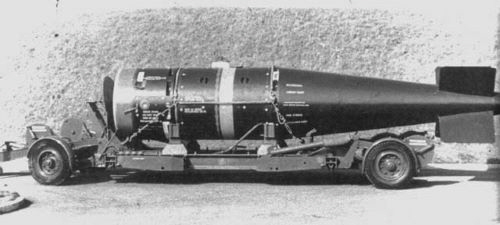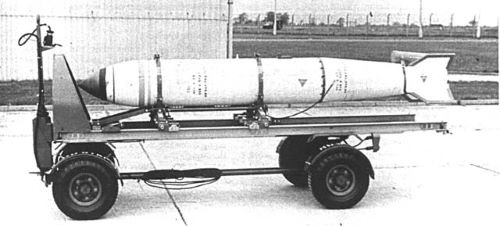Blue Danube and Red Beard
The first operational UK nuclear weapons carried by the Lincolnshire based V Bombers and stored and maintained at RAF Faldingworth, Lincolnshire post war

Blue Danube A Bomb
Blue Danube was the first operational British nuclear weapon. It was also referred to as Smallboy, the Mk I Atom Bomb, Special Bomb and OR1001.
The the latest jet bombers of the RAF V bomber force were planned to accommodate the Blue Danube bomb as their primary weapon prior to the first hydrogen bomb detonation. At that time the British military planners believed an atomic war would be fought using atomic bombs of similar yield to those used against Japan in WW2. For that reason the stockpile planned was for up to 800 bombs with yields of 10 to 12 kilotons. V-bomber bomb bays were designed to carry Blue Danube which was the smallest nuclear bomb that was possible to be designed in 1947 when the plans were developed.
Initial designs for the Blue Danube warhead were based on research derived from Hurricane, the first British experimental fission device tested in 1952. The actual Blue Danube warhead was tested during Operation Buffalo in the autumn of 1956 at Maralinga, Australia by a team of Australian, British and Canadian scientists.
On the 11 October 1956 a Vickers Valiant of 49 Squadron RAF piloted by S/L Ted Flavell became the first British aircraft to drop a live atomic bomb.
Blue Danube added a ballistic shaped casing to the existing Hurricane physics package with four flip-out fins to ensure a stable ballistic trajectory from the planned release height of 50,000 ft. It initially used a plutonium core but all service versions were modified to use a composite plutonium/U-235 core.
The service chiefs insisted on a yield of between 10-12 kt for two reasons: -
1/ To minimise usage of scarce and expensive fissile material.
2/ To minimise the risk of pre-detonation, a phenomenon then little understood and the primary reason for using a composite core of concentric shells of plutonium and U-235.
Although there were many plans for versions with higher yields none were developed, largely because of the scarcity of fissile materials.
The first Blue Danube was delivered to stockpile at RAF Wittering in November 1953 although there were no aircraft equipped to carry it until the following year. No. 1321 Flight RAF was established at RAF Wittering in April 1954 as a Vickers Valiant unit to integrate the Blue Danube nuclear weapon into RAF service. The Short Sperrin was also able to carry the Blue Danube and had been ordered as a fall-back option in case the V-bomber projects proved unsuccessful.
58 Blue Danubes were produced before production switched in 1958 to the smaller and more capable Red Beard weapon which could accept the Blue Danube fissile core and also could be carried by much smaller aircraft. It seems unlikely that all 58 Blue Danube weapons were operational at any given time. Blue Danube was retired in 1962.
Bomb storage facilities for the weapon were built at RAF Barnham in Suffolk and RAF Faldingworth in Lincolnshire.
Major problems with Blue Danube included the use of unreliable accumulators to supply power to the firing circuits and radar altimeters. Later weapons used the more reliable ram air turbine-generators or thermal batteries. Blue Danube was not built to withstand the rigours of service life and needed to be re-engineered to meet service requirements resulting in Red Beard and later Yellow Sun and WF177 weapons.

Red Beard

Yellow Sun

WF177.
Compiled by David Fell. Many thanks to the Britain's Nuclear Weapons - History of the British Nuclear Arsenal websites
....................
|